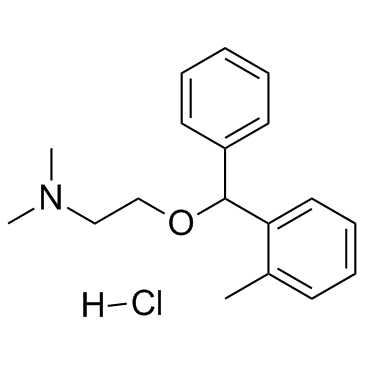Orphenadrine hydrochloride

Orphenadrine hydrochloride structure
|
Common Name | Orphenadrine hydrochloride | ||
|---|---|---|---|---|
| CAS Number | 341-69-5 | Molecular Weight | 305.84200 | |
| Density | 1.014g/cm3 | Boiling Point | 363ºC at 760mmHg | |
| Molecular Formula | C18H24ClNO | Melting Point | 156 - 157ºC | |
| MSDS | Chinese USA | Flash Point | 107.1ºC | |
| Symbol |

GHS06 |
Signal Word | Danger | |
Use of Orphenadrine hydrochlorideOrphenadrine hydrochloride is an uncompetitive N-methyl-D-aspartate (NMDA) receptor antagonist with Ki of 6.0 ±0.7 μM.IC50 value: 6.0 ±0.7 μM (Ki)Target: NMDA ReceptorOrphenadrine has been used as an antiparkinsonian, antispastic and analgesic drug. Orphenadrine inhibits [3H]MK-801 binding to the phencyclidine (PCP) binding site of the N-methyl-D-aspartate (NMDA)-receptor in homogenates of postmortem human frontal cortex with a Ki-value of 6.0 ±0.7 μM. The NMDA receptor antagonistic effects of orphenadrine were assessed using concentration- and patch-clamp techniques on cultured superior colliculus neurones. Orphenadrine blocked open NMDA receptor channels with fast kinetics and in a strongly voltage-dependent manner. The IC50-value against steady state currents at -70 mV was 16.2 ± 1.6 μM (n = 6). [1]. Orphenadrine competitively inhibited [3H]nisoxetine binding in rat vas deferens membranes (Ki = 1.05 ±0.20 μM). It can be concluded that orphenadrine, at low micromolar concentrations, interacts with the noradrenaline reuptake system inhibiting its functionality and thus potentiating the effect of noradrenaline [2]. |
| Name | orphenadrine hydrochloride |
|---|---|
| Synonym | More Synonyms |
| Description | Orphenadrine hydrochloride is an uncompetitive N-methyl-D-aspartate (NMDA) receptor antagonist with Ki of 6.0 ±0.7 μM.IC50 value: 6.0 ±0.7 μM (Ki)Target: NMDA ReceptorOrphenadrine has been used as an antiparkinsonian, antispastic and analgesic drug. Orphenadrine inhibits [3H]MK-801 binding to the phencyclidine (PCP) binding site of the N-methyl-D-aspartate (NMDA)-receptor in homogenates of postmortem human frontal cortex with a Ki-value of 6.0 ±0.7 μM. The NMDA receptor antagonistic effects of orphenadrine were assessed using concentration- and patch-clamp techniques on cultured superior colliculus neurones. Orphenadrine blocked open NMDA receptor channels with fast kinetics and in a strongly voltage-dependent manner. The IC50-value against steady state currents at -70 mV was 16.2 ± 1.6 μM (n = 6). [1]. Orphenadrine competitively inhibited [3H]nisoxetine binding in rat vas deferens membranes (Ki = 1.05 ±0.20 μM). It can be concluded that orphenadrine, at low micromolar concentrations, interacts with the noradrenaline reuptake system inhibiting its functionality and thus potentiating the effect of noradrenaline [2]. |
|---|---|
| Related Catalog | |
| References |
| Density | 1.014g/cm3 |
|---|---|
| Boiling Point | 363ºC at 760mmHg |
| Melting Point | 156 - 157ºC |
| Molecular Formula | C18H24ClNO |
| Molecular Weight | 305.84200 |
| Flash Point | 107.1ºC |
| Exact Mass | 305.15500 |
| PSA | 12.47000 |
| LogP | 4.46460 |
| Storage condition | 2-8°C |
| Stability | Stable. Incompatible with strong oxidizing agents. |
CHEMICAL IDENTIFICATION
HEALTH HAZARD DATAACUTE TOXICITY DATA
|
| Symbol |

GHS06 |
|---|---|
| Signal Word | Danger |
| Hazard Statements | H301 |
| Precautionary Statements | Missing Phrase - N15.00950417 |
| Personal Protective Equipment | dust mask type N95 (US);Eyeshields;Faceshields;Gloves |
| Hazard Codes | Xn |
| Risk Phrases | R22 |
| Safety Phrases | S36 |
| RIDADR | 3249 |
| RTECS | KR6300000 |
| Packaging Group | III |
| Hazard Class | 6.1(b) |
| HS Code | 2922199090 |
| HS Code | 2922199090 |
|---|---|
| Summary | 2922199090. other amino-alcohols, other than those containing more than one kind of oxygen function, their ethers and esters; salts thereof. VAT:17.0%. Tax rebate rate:13.0%. . MFN tariff:6.5%. General tariff:30.0% |
|
Preclinical evaluation of marketed sodium channel blockers in a rat model of myotonia discloses promising antimyotonic drugs.
Exp. Neurol. 255 , 96-102, (2014) Although the sodium channel blocker mexiletine is considered the first-line drug in myotonia, some patients experiment adverse effects, while others do not gain any benefit. Other antimyotonic drugs a... |
|
|
Reduction of tinnitus severity by the centrally acting muscle relaxant cyclobenzaprine: an open-label pilot study.
Audiol. Neurootol. 17(3) , 179-88, (2012) Tinnitus, the phantom perception of sounds, is a highly prevalent disorder. Although a wide variety of drugs have been investigated off label for the treatment of tinnitus, there is no approved pharma... |
|
|
Anticholinergic antiparkinson drug orphenadrine inhibits HERG channels: block attenuation by mutations of the pore residues Y652 or F656.
Naunyn Schmiedebergs Arch. Pharmacol. 376(4) , 275-84, (2007) The anticholinergic antiparkinson drug orphenadrine is an antagonist at central and peripheral muscarinic receptors. Orphenadrine intake has recently been linked to QT prolongation and Torsade-de-Poin... |
| N,N-Dimethyl-2-(2-methylbenzhydryloxy)ethylamine Hydrochloride |
| MFCD00012480 |
| Mefenamin hydrochloride |
| Orphenadrinehydrochloride |
| Orphenadrine |
| EINECS 206-435-4 |
| Mebedrol |
| orphenadrine*HCl |
| N,N-dimethyl-2-[(2-methylphenyl)-phenylmethoxy]ethanamine,hydrochloride |
| Mephenamine hydrochloride |
| Mephenamin hydrochloride |
| Mephenamine |
| Orphenadrine hydrochloride |
| Disipal |
| Orfenadrin hydrochloride |
| Mephenamin |

